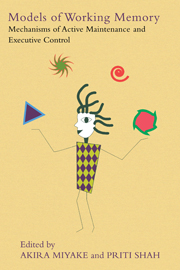Book contents
- Frontmatter
- Contents
- List of Contributors
- Dedication
- Preface
- Ode on Working Memory
- Acknowledgments
- 1 Models of Working Memory: An Introduction
- 2 Working Memory: The Multiple-Component Model
- 3 An Embedded-Processes Model of Working Memory
- 4 Individual Differences in Working Memory Capacity and What They Tell Us About Controlled Attention, General Fluid Intelligence, and Functions of the Prefrontal Cortex
- 5 Modeling Working Memory in a Unified Architecture: An ACT-R Perspective
- 6 Insights into Working Memory from the Perspective of the EPIC Architecture for Modeling Skilled Perceptual-Motor and Cognitive Human Performance
- 7 The Soar Cognitive Architecture and Human Working Memory
- 8 Long-Term Working Memory as an Alternative to Capacity Models of Working Memory in Everyday Skilled Performance
- 9 Interacting Cognitive Subsystems: Modeling Working Memory Phenomena Within a Multiprocessor Architecture
- 10 Working Memory in a Multilevel Hybrid Connectionist Control Architecture (CAP2)
- 11 A Biologically Based Computational Model of Working Memory
- 12 Models of Working Memory: Eight Questions and Some General Issues
- 13 Toward Unified Theories of Working Memory: Emerging General Consensus, Unresolved Theoretical Issues, and Future Research Directions
- Name Index
- Subject Index
9 - Interacting Cognitive Subsystems: Modeling Working Memory Phenomena Within a Multiprocessor Architecture
Published online by Cambridge University Press: 05 June 2012
- Frontmatter
- Contents
- List of Contributors
- Dedication
- Preface
- Ode on Working Memory
- Acknowledgments
- 1 Models of Working Memory: An Introduction
- 2 Working Memory: The Multiple-Component Model
- 3 An Embedded-Processes Model of Working Memory
- 4 Individual Differences in Working Memory Capacity and What They Tell Us About Controlled Attention, General Fluid Intelligence, and Functions of the Prefrontal Cortex
- 5 Modeling Working Memory in a Unified Architecture: An ACT-R Perspective
- 6 Insights into Working Memory from the Perspective of the EPIC Architecture for Modeling Skilled Perceptual-Motor and Cognitive Human Performance
- 7 The Soar Cognitive Architecture and Human Working Memory
- 8 Long-Term Working Memory as an Alternative to Capacity Models of Working Memory in Everyday Skilled Performance
- 9 Interacting Cognitive Subsystems: Modeling Working Memory Phenomena Within a Multiprocessor Architecture
- 10 Working Memory in a Multilevel Hybrid Connectionist Control Architecture (CAP2)
- 11 A Biologically Based Computational Model of Working Memory
- 12 Models of Working Memory: Eight Questions and Some General Issues
- 13 Toward Unified Theories of Working Memory: Emerging General Consensus, Unresolved Theoretical Issues, and Future Research Directions
- Name Index
- Subject Index
Summary
FIVE CENTRAL FEATURES OF THE THEORY
(1) The cognitive mechanisms underlying working memory performance involve multiple processes and types of mental representation.
(2) The detailed properties of performance depend on the configuration of specific processes needed to accomplish the task and the specific types of memory records they access and use in executing the task.
(3) There are no specific capacity limitations on what is stored at any particular level of mental representation. Capacity limitation arises out of restrictions on the interfunctioning of processes within a wider system.
(4) The use of memory records requires the generation or revival of a description of the content to be accessed. This can also functionally constrain performance.
(5) There is no unified “central executive” component; central executive functions are themselves accomplished by processing interactions among subsystems.
The dominant approach to formulating theory within experimental psychology is to develop models of restricted scope and capability. Individual models strive to predict properties of behavior in tasks that are assumed to tap specific mental faculties such as visual perception, language, problem solving, emotion, memory, or motor skills. It is taken for granted that moving toward an understanding of the complete mental mechanism is rather like solving a jigsaw puzzle. Ultimately a complete picture should emerge as local theories become validated and as segments of increasing size emerge and are themselves pieced together. One problem with this approach is the very complexity of the interrelationships between the various mental faculties.
- Type
- Chapter
- Information
- Models of Working MemoryMechanisms of Active Maintenance and Executive Control, pp. 298 - 339Publisher: Cambridge University PressPrint publication year: 1999
- 27
- Cited by

